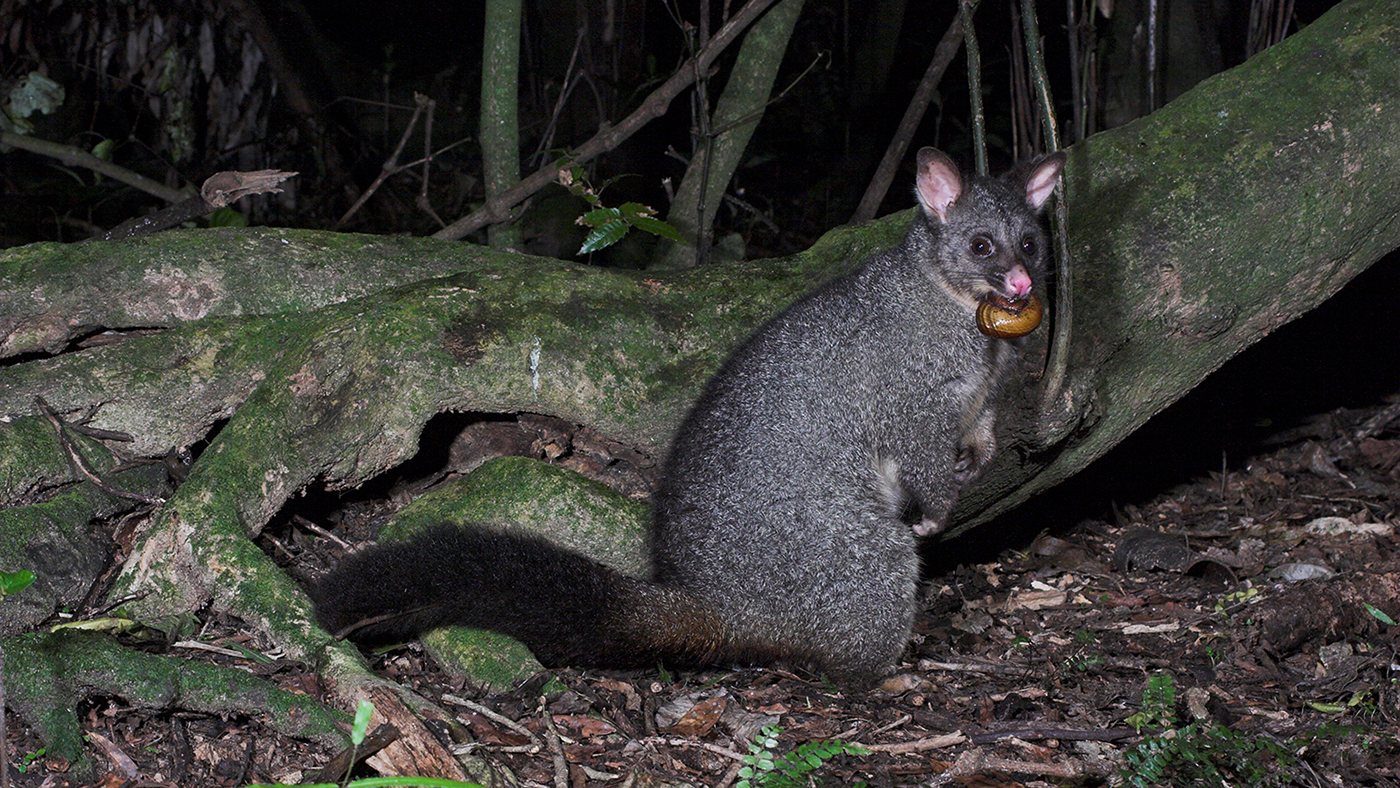| Management programme |
|
Sustained control (excluding the Hūnua Pest Management Area) Site-led (Hūnua Pest Management Area) |
| Objective |
| Reduce the numbers and impacts of possums particularly in priority possum control areas (PPCA) and on land adjacent to areas where possums are being controlled across the Waikato region. |
| Impacts |
| Economic, biodiversity, soil resources, human health, social and cultural wellbeing, amenity/recreation, animal welfare |
Brushtail possums, native to Australia, were introduced to New Zealand between 1837 and 1898 to establish a fur trade. Initially a protected animal, this status was lifted in 1947 when it became apparent that the environmental damage caused by possums outweighed any profit from the sale of its skins. Today, possums are considered to be the major ecological and agricultural vertebrate animal pest in New Zealand.

What do they look like?
Possums are generally similar in size to a cat but their size, weight (average 2kg to 3kg) and colouring can vary greatly throughout New Zealand. Males are generally larger than females. They are a marsupial, which means females carry their young in a pouch. Possums reach maturity at between 1 and 2 years old and have an average lifespan of 7-10 years.
- Possums have a small head with a pointed snout and oval ears.
- They have large eyes and catlike whiskers characteristic of nocturnal animals.
- Their thick, woolly fur is brown, silver-grey, black, or cream (or a combination of shades).
- They have a long black bushy tail.
- They have a darkly stained sternal gland on their chest.
Why are they pests?
Possums have a significant impact on many of the Waikato region’s natural ecosystems. They prey on the eggs and chicks of various threatened and culturally valued birds, including kōkako, and compete for nest sites with hole-nesting birds, like saddlebacks and native parrots like kākā. They also compete directly with native birds and reptiles for food by eating the same buds, flowers, fruit/berries and nectar. Possums also eat invertebrates including wētā and are a significant predator of our native land snails.
Heavy selective browsing by possums can suppress or eliminate preferred plants. This can alter the vegetation composition in invaded ecosystems, ultimately leading to the collapse of palatable canopy species like kāmahi, pōhutukawa or northern rātā. Possums are also considered serious agricultural pests. They are vectors for bovine TB in cattle and compete directly with stock for pasture. They also have the potential to transmit diseases to humans.
Checking for signs of possums
To check for possums, look out for the distinctive signs of possum browse. Possums usually feed on foliage by holding branches in their paws, using their teeth to tear the leaves. They usually leave behind the leaf stalk, base and midrib and some tattered leaf remnants. Look out for discarded and partially eaten leaves, flowers and fruit beneath feed trees. Heavy and persistent possum browsing will kill a tree.
Other signs of possums to look out for include:
- ‘runs’ (tracks) used nightly by possums to travel to and from feeding areas (very distinctive in grassed areas)
- claw marks on trees, fence posts and gates
- bark biting (horizontal bites) on trees
- possum droppings scattered under food trees and in the forks of trees
- droppings approximately 2.5cm long and slightly thicker than a pencil.
Discouraging possums
Repellents, tree guards and fence barriers
- There are a number of repellents designed to deter possums and other browsing animals from damaging young trees, however, they do not provide total protection. Repellents are not practicable for tuberculosis (TB) control or protecting native forests.
- Tree guards are physical barriers used to keep possums from damaging young trees and seedlings. Sheet metal strips or bands (40 to 45cm wide) effectively stop possums from climbing a tree.
Habitat manipulation
Reduce suitable possum habitat by removing piles of logs, dead trees and stumps. Where possible, block off entry into sheds, roofs and buildings.
Possum as pets
Under the council’s Regional Pest Management Plan, it is illegal to keep a possum as a pet.
How can I control them?
There are a range of control tools available for possums, including trapping, shooting and poisoning.
Predator Free New Zealand and Bionet have best practice advice on their websites for landowners and community groups on how to undertake possum control.
You can also speak to one of our pest animal staff for advice and information on controlling possums on freephone 0800 800 401.
More information
- For information and advice on possums, contact Waikato Regional Council on freephone 0800 800 401.
- For information and advice on possums in relation to the Hūnua Ranges Pest Management Area, contact Auckland Council on 09 301 0101 or email pestfree@aucklandcouncil.govt.nz.






